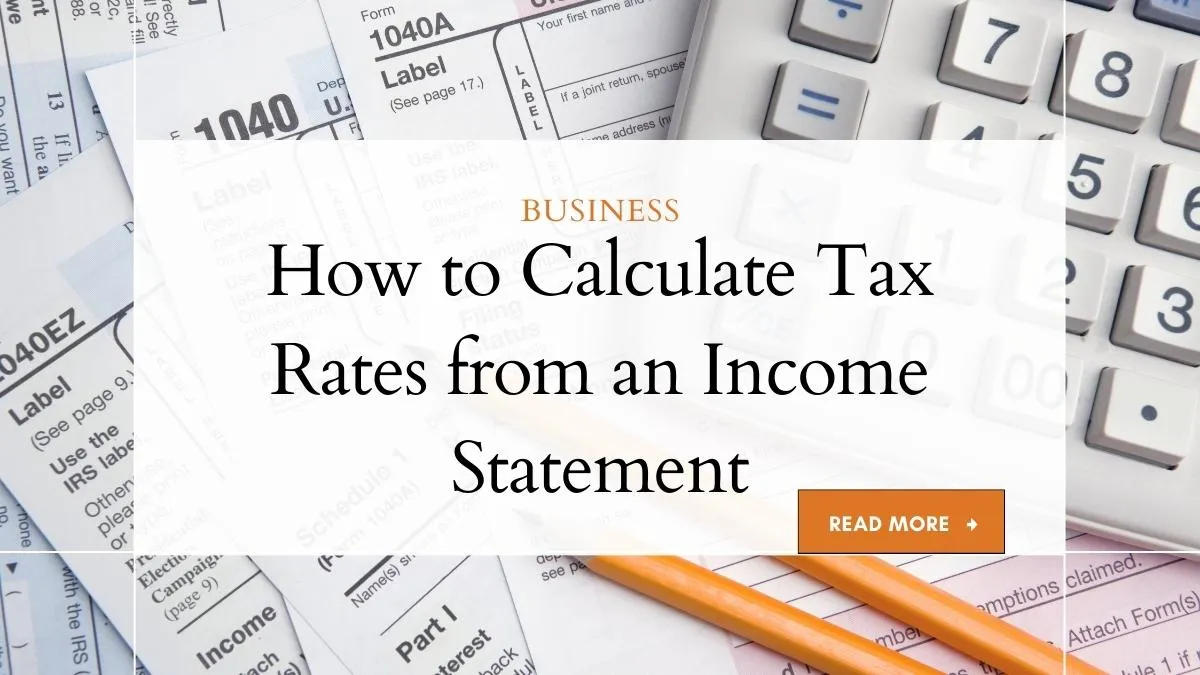
Tax rate is the percentage of an individual’s or company’s income that is paid to the government as taxes. It is a crucial element in financial planning and budgeting as taxes can significantly affect a company’s profitability and an individual’s take-home pay.
Understanding how to calculate tax rates accurately can help individuals and businesses make informed financial decisions and minimize their tax liabilities.
An income statement, also known as a profit and loss statement, is a financial statement that summarizes a company’s revenues and expenses over a specific period, usually a quarter or a year.
The income statement provides valuable insights into a company’s financial performance, including its profitability, revenue sources, and cost structure.
The purpose of this guide is to provide readers with a comprehensive understanding of how to calculate tax rate from income statement.
The guide will cover the key components of an income statement, the calculation of taxable income, and the determination of tax rates.
Also, you can able to know,
Understanding the Income Statement
The income statement is one of the most important financial statements used by individuals and businesses to assess their financial performance.
It provides a summary of a company’s revenues, expenses, and net income over a specific period, typically a fiscal quarter or year.
Understanding the income statement is crucial for investors, creditors, and business owners, as it helps them evaluate the profitability and financial health of a company.
In this section, we will provide an overview of the income statement and its components, including revenue, expenses, and net income, as well as the role of tax expenses in determining net income.
By the end of this section, readers will have a clear understanding of the key components of the income statement and their importance in financial analysis.
Don’t miss: How to Become an Investor
What is the Income Statement
The income statement consists of three main components: revenue, expenses, and net income. Revenue is the total amount of money earned by a company from the sale of its products or services.
Expenses are the costs incurred by a company to generate revenue, including salaries, rent, utilities, and depreciation. Net income is the difference between revenue and expenses and represents a company’s profit or loss for the period.
Explanation of Revenue, Expenses, and Net Income
Revenue is the total amount of money a company earns from its primary business activities, including the sale of goods or services. It is typically the top line of the income statement.
Expenses are the costs incurred by a company to generate revenue. There are two types of expenses: operating expenses and non-operating expenses.
Operating expenses are the costs associated with running a business, such as salaries, rent, utilities, and depreciation.
Non-operating expenses are expenses that are not directly related to the primary business activities, such as interest expenses or losses from investments.
Net income is the difference between revenue and expenses. It is a measure of a company’s profitability for the period.
If revenue is greater than expenses, the company has a net income. If expenses are greater than revenue, the company has a net loss.
Brief Introduction to Tax Expenses on the Income Statement
Tax expenses represent the amount of income tax owed by a company for the period. Tax expenses are typically included in the income statement as a separate line item, below net income.
Companies must pay income tax on their profits, and the tax expense reflects the portion of the company’s income that is paid to the government as taxes.
Calculating Taxable Income
Calculating taxable income is a critical step in the process of determining an individual or business’s tax liability. Taxable income is the portion of income that is subject to taxation by the government.
It is calculated by making adjustments to the net income figure reported on the income statement, which includes deductions, credits, and other tax-related adjustments.
Understanding how to calculate taxable income is essential for individuals and businesses, as it can help them minimize their tax liability and maximize their after-tax income.
In this section, we will provide a detailed explanation of taxable income, the adjustments made to net income for tax purposes, and the role of tax deductions and credits in reducing tax liability.
By the end of this section, readers will have a clear understanding of how to calculate taxable income and optimize their tax planning.
What is the Taxable Income
Taxable income is the amount of income that is subject to taxation after accounting for deductions and credits.
In other words, it is the income that is left over after subtracting allowable expenses and deductions.
Adjustments to Net Income for Tax Purposes
To calculate taxable income, adjustments must be made to net income for tax purposes.
These adjustments include adding back certain expenses that are not deductible for tax purposes, such as depreciation and amortization, and subtracting allowable deductions and credits, such as charitable contributions and business expenses.
Tax Deductions and Credits
Tax deductions and credits are amounts that can be subtracted from the taxable income, reducing the amount of tax owed.
Tax deductions are expenses that are deductible for tax purposes, such as business expenses or charitable contributions.
Tax credits are dollar-for-dollar reductions in the amount of tax owed, such as the child tax credit or the earned income tax credit.
Determining the Tax Rate.
Determining the tax rate is a crucial step in calculating an individual or business’s tax liability. The tax rate is the percentage of taxable income that must be paid in taxes to the government.
In most countries, the tax rate is determined by a progressive tax system, where the tax rate increases as the taxable income increases.
The tax system is typically structured around tax brackets, which determine the tax rate based on a range of income levels.
Understanding how the tax rate is determined is essential for individuals and businesses, as it can help them make informed decisions regarding tax planning and budgeting.
In this section, we will provide an overview of marginal tax rates, tax brackets, and how they work together to determine the tax rate based on taxable income.
By the end of this section, readers will have a clear understanding of how to determine the tax rate and how it affects their overall tax liability.
What is the Marginal Tax Rates
Marginal tax rates refer to the tax rate applied to the last dollar of taxable income earned. In other words, as taxable income increases, the tax rate applied to the additional income also increases.
Marginal tax rates are typically used to determine the tax liability for individuals and businesses.
What is the Tax Brackets and How They Work
Tax brackets are a range of incomes that are subject to a particular tax rate. The tax system in most countries is progressive, meaning that as income increases, the tax rate also increases.
Tax brackets are used to calculate the tax liability for individuals and businesses based on their taxable income.
Calculation of Tax Rate Based on Taxable Income
To calculate the tax rate based on taxable income, an individual or business must determine the tax bracket that their taxable income falls into and the corresponding marginal tax rate.
The tax rate can then be calculated by multiplying the taxable income by the marginal tax rate.
Examples and Practice Problems
Examples and practice problems are essential for readers to fully understand how to calculate the tax rate from an income statement.
In this section, we will provide a series of examples that illustrate how to calculate the tax rate based on various income statement data.
These examples will cover different scenarios and help readers understand how tax deductions and credits can impact the tax rate.
Additionally, we will provide a set of practice problems for readers to solve on their own. By practicing these problems, readers can apply their knowledge of tax calculations and strengthen their understanding of the tax rate calculation process.
By the end of this section, readers will have gained valuable hands-on experience in calculating the tax rate and be better equipped to handle tax-related issues in the future.
Calculating Tax Rate Using Income Statement Data
Example 1:
A company has a net income of $100,000 and a tax expense of $30,000. What is the company’s tax rate?
Solution:
Taxable income = net income – tax expense
Taxable income = $100,000 – $30,000 = $70,000
To determine the tax rate, we need to know the tax bracket that the company’s taxable income falls into. Let’s assume that the company’s taxable income falls into the 22% tax bracket.
Tax rate = taxable income x marginal tax rate
Tax rate = $70,000 x 22% = $15,400
Therefore, the company’s tax rate is $15,400.
Practice Problems for Readers to Try on Their Own
A self-employed individual has a net income of $75,000 and has incurred $10,000 in business expenses. What is the individual’s taxable income, assuming a tax deduction rate of 20%?
A company has a net income of $500,000 and a tax expense of $150,000. What is the company’s tax rate, assuming a marginal tax rate of 35%?
Calculating Your Tax Rate FAQs
Here is the frequently asked questions and answers on calculating your tax rate. It covers topics such as marginal tax rates, taxable income, tax deductions, and more, to help readers understand how to determine their tax liability accurately.
What is the formula for tax rate in Excel?
There is no specific formula for tax rate in Excel as it depends on the tax system and its rules of each country. Tax rates are typically determined by tax brackets, which can be used in Excel to calculate the tax liability based on a given taxable income using a series of IF statements or LOOKUP functions.
What is the formula for calculation of rate of return after tax?
The formula for calculating the rate of return after tax is:
(Rate of return before tax) x (1 – Tax rate) = Rate of return after tax
This formula takes into account the pre-tax rate of return on an investment and subtracts the tax liability to determine the after-tax rate of return. The tax rate used in the formula can be the marginal tax rate or the effective tax rate depending on the specific situation.
What is the formula for net income before tax?
The formula for net income before tax is:
Net income before tax = Total revenue – Total expenses
This formula calculates the amount of income that a business or individual has earned before any taxes have been deducted. Total revenue is the sum of all sales or revenue generated during a specific period, while total expenses include all the costs incurred to generate that revenue, such as salaries, rent, utilities, and other operating expenses.
How do you calculate a company’s marginal tax rate?
To calculate a company’s marginal tax rate, you need to determine the tax rate applicable to the next dollar of taxable income earned. The formula for calculating marginal tax rate involves finding the tax liability at different income levels and calculating the change in tax liability for each additional dollar of income. Marginal tax rate can be calculated using the following formula:
Marginal tax rate = (Change in tax liability) / (Change in taxable income)
How to calculate net income?
The formula for calculating net income is:
Net income = Total revenue – Total expenses
Net income is the profit generated by a business or an individual after deducting all the expenses from total revenue. Total revenue includes all income earned during a specific period, while total expenses include all costs incurred to generate that revenue, such as salaries, rent, utilities, and other operating expenses.
Don’t miss: How to Become a Tax Lawyer
The bottom line
In this guide, we discussed the importance of tax rates, the components of an income statement, and how to calculate tax rate from income statement.
We covered the calculation of taxable income, adjustments to net income for tax purposes, and the determination of tax rates based on taxable income and marginal tax rates.
Calculating tax rates can be complex and requires a thorough understanding of the tax system and income statement components.
It is recommended that individuals and businesses consult with tax professionals for advice and guidance.
For more information on taxes and financial planning, readers can refer to the websites of relevant government agencies, such as the Internal Revenue Service (IRS) in the United States or the Canada Revenue Agency (CRA) in Canada.
There are also numerous books and online resources available on the topic of taxes and financial planning.










